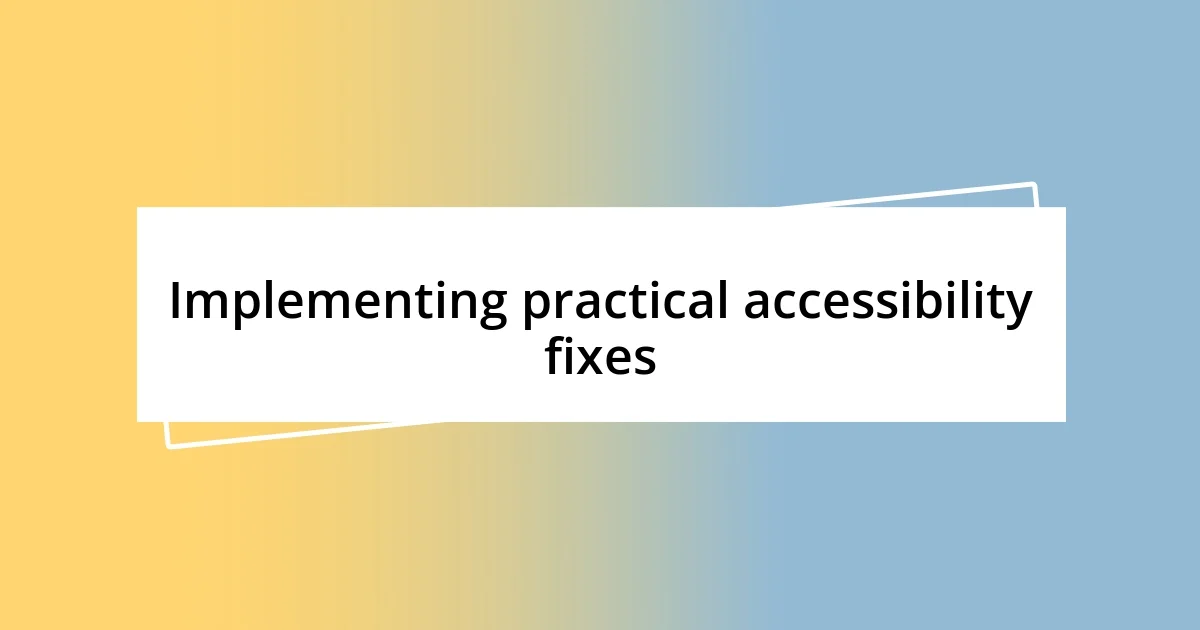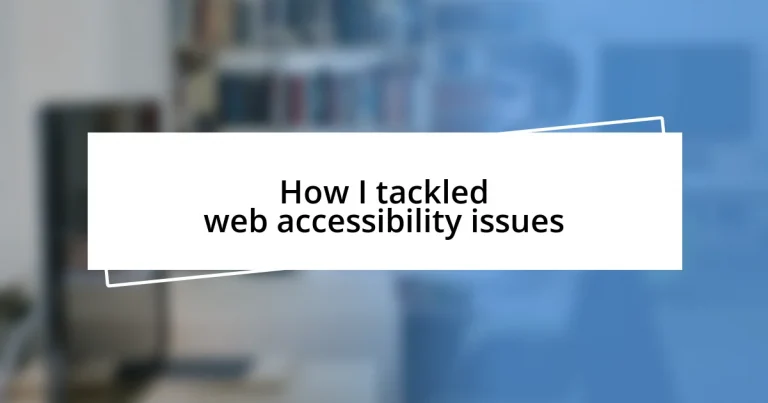Key takeaways:
- Understanding web accessibility goes beyond compliance; it involves empathy and the desire to create an inclusive digital environment for all users.
- Identifying common accessibility barriers—like keyboard navigation challenges and insufficient color contrast—highlights the importance of thoughtful design choices.
- Continuous improvement and collective team efforts in monitoring accessibility initiatives foster a culture of accountability and enhance user experiences.

Understanding web accessibility requirements
Understanding web accessibility requirements can feel overwhelming at first, but I found that breaking them down into manageable parts made all the difference. For instance, I remember feeling frustrated when I first encountered the Web Content Accessibility Guidelines (WCAG). These guidelines emphasize making web content more accessible to people with disabilities, but they are more than just a checklist; they are a means of fostering inclusivity.
As I navigated this journey, I came to appreciate the importance of perceivable content. Imagine a visually impaired user trying to understand your website. How would they feel if they couldn’t access vital information because there were missing alternative text descriptions? It’s a humbling thought that really motivated me to prioritize this aspect of accessibility.
One of the eye-opening moments for me was realizing that accessibility isn’t just about compliance; it’s about empathy. When I adapted my sites to meet the requirements, I not only improved user experience for everyone but also discovered a sense of purpose in my work. It made me question: how often do we think about the diverse needs of our users, and how can we truly create spaces where everyone belongs?

Identifying common accessibility barriers
Identifying common accessibility barriers is crucial in making the web an inclusive space. I often reflect on personal encounters that emphasized these gaps. For example, while testing a website, I discovered that keyboard navigation was almost impossible for a friend with motor difficulties. This revelation was a stark reminder of how small, seemingly trivial details can create significant barriers for users who rely on different modes of interaction.
Another important barrier I’ve encountered is insufficient color contrast. I distinctly remember receiving feedback from a color-blind colleague who struggled to read form fields due to poor differentiation from the background. This experience highlighted the importance of thoughtful design choices. Tools for checking color contrast became my best friends as I worked to ensure that text stood out against its background for all users.
Something as simple as video captions can also be an accessibility stumbling block. In a team meeting, a teammate shared their frustration over missing captions on recorded videos, which made it challenging for them to follow along due to hearing impairments. It was a pivotal moment that drove home the point that accessibility is not just an obligation; it’s a shared responsibility to create an environment where everyone can participate equally.
| Accessibility Barrier | Description |
|---|---|
| Keyboard Navigation | Challenges faced by users with motor difficulties in navigating websites using a keyboard. |
| Color Contrast | Poor differentiation between background and text can hinder visibility for users with color blindness. |
| Video Captions | Missing captions on videos create barriers for users with hearing impairments. |

Conducting an accessibility audit
Conducting an accessibility audit
Conducting an accessibility audit can feel like looking through a magnifying glass at every nuance of your website. I remember sitting down with a checklist and running through pages, feeling a mix of excitement and anxiety. I often thought, “What if I miss something critical?” That fear drove me to be methodical. I focused on each element and how it interacted with users who might face challenges.
In this process, I found some surprising barriers that I initially overlooked. Here are a few key focus areas to consider during your audit:
- Alt Text Analysis: Are all images accompanied by descriptive alt text? I learned the hard way that leaving these blank can exclude sight-impaired visitors entirely.
- Keyboard Navigation: Test your site without a mouse. I once realized how often I relied on my mouse until a colleague couldn’t even access the menu.
- Form Accessibility: Check if all form fields have labels and error notifications. I was shocked to find a form I designed that didn’t make sense to users who relied on screen readers.
- Color Contrast Checker: Using online tools, I evaluated color contrasts. I recall the relief I felt when I ensured that all text was visible for my color-blind friend.
- Responsive Design: Test how your site appears on various devices. One day, I had a revelation about how my site looked on mobile; it made me rethink the entire user experience.
These steps helped me uncover not just issues but also opportunities to enhance usability. Each audit revealed the real possibility of connecting with users in meaningful ways. The more I worked through these details, the more I understood that accessibility is a journey, and every step taken brings me closer to creating a digital space where everyone is welcome.

Implementing practical accessibility fixes
Implementing practical accessibility fixes is where theory meets action, and that’s where the real work begins. I vividly recall the day I added keyboard shortcuts to a web application I developed. I thought to myself, “Imagine if I had to navigate this site with just a keyboard.” It felt rewarding to enhance usability for users with mobility challenges, and it really solidified my belief in the power of user-centered design.
Another fix that made a notable difference was improving the color contrast across the website. I remember adjusting the shades of buttons and text one afternoon, thinking, “Will this truly help those with vision impairments?” The moment I read feedback from a user who expressed their appreciation for the enhanced readability was a powerful reminder that small changes can lead to a profound impact on someone’s online experience.
Lastly, I realized how crucial it was to ensure that all videos included accurate captions. I once spent a few hours meticulously reviewing transcript files, thinking about how frustrating it must be for someone who relies on these features. When I finally enabled them, the positive reactions from the team member who initially struggled with understanding video content felt like a small victory. Implementing these practical fixes was not just about compliance but fostering a more inclusive environment for everyone.

Testing for accessibility compliance
Testing for accessibility compliance can sometimes feel overwhelming, but it’s crucial for ensuring your website serves everyone. I remember setting up an automated accessibility testing tool for the first time and feeling a mix of hope and dread. I was curious—would it catch every issue? Spoiler: it didn’t. This highlighted why manual testing is just as essential; the nuances of user experience often escape automated systems.
When I dove into user testing, I invited individuals with diverse abilities to navigate my site. Watching them struggle in real-time was eye-opening. I sat silently, reflecting on their experiences and repeatedly asking myself, “How did I overlook these obstacles?” Every moment spent observing their reactions reinforced the importance of incorporating feedback and making real-time adjustments. It’s a dynamic process, where each user’s perspective helps you see your site through a new lens.
Ultimately, compliance isn’t only about ticking boxes; it’s about empathy. I think back to a time when a friend shared her frustration with inaccessible online forms. That conversation ignited my passion to improve our digital landscape. Have you ever had a similar moment that changed your perspective on accessibility? It’s those personal connections that drive change and inspire us to create a truly inclusive environment for all users.

Educating the team on accessibility
I found that educating the team on accessibility starts with creating awareness and understanding among all members. I remember one of our first workshops where we sat down to discuss the fundamentals of web accessibility. As I shared stories about users living with disabilities and their everyday challenges, you could feel the room shift—there was a palpable realization that accessibility isn’t just a checkbox; it’s about valuing every user’s experience. It made me wonder, how often do we overlook the needs of others simply because we aren’t aware of their struggles?
To solidify this knowledge, we held brainstorming sessions where team members shared their own experiences or ideas for enhancing accessibility. I vividly recall a colleague sharing how a family member with a visual impairment navigated websites. Her story resonated deeply, sparking conversations about specific design choices that could make our site better. It was a powerful moment for me—seeing my teammates’ expressions of concern and commitment made it clear that empathy can catalyze real change.
Furthermore, we developed an ongoing training schedule focused on accessibility. I believe this was crucial as it transformed our approach from a one-time workshop into a continuous journey. At one session, we discussed the importance of screen readers and even practiced using one. Watching my team members struggle and then triumph as they adapted their content was invigorating. It posed a reflective question: what if every team approached accessibility with this level of commitment? It truly is a step toward building a digital space that everyone can comfortably inhabit.

Continuous improvement and monitoring
Continuous improvement in accessibility is a never-ending journey. I remember the moment I set up a monthly accessibility check-in with my team. Seeing everyone rally around the idea reinforced my belief that improvement doesn’t happen in isolation; it thrives on collaboration. We’d review our progress, tackle new guidelines, and celebrate any wins, no matter how small. Does your team regularly assess its accessibility efforts? I find that regular touchpoints can inspire a culture of accountability and growth.
Monitoring goes beyond just compliance—it’s about actively engaging with users and their experiences. After a recent site redesign, I received feedback from a visually impaired user who commented on an improved navigation feature. I felt a surge of pride, but it also sparked a realization: every single piece of feedback is an opportunity for growth. That user’s suggestion led to implementing additional features that enhanced usability for everyone. What if we viewed every critique as a stepping stone toward excellence?
I learned that accessibility improvements can come from unexpected places. One day, a junior developer casually mentioned a new accessibility plugin she discovered. I hadn’t considered it before, and her enthusiasm was infectious. That plug-in cut down our workload significantly regarding compliance, reminding me that innovation often springs from fresh perspectives. Embracing a mindset of ongoing improvement means being open to ideas from everyone on the team, even those who are just starting out.













